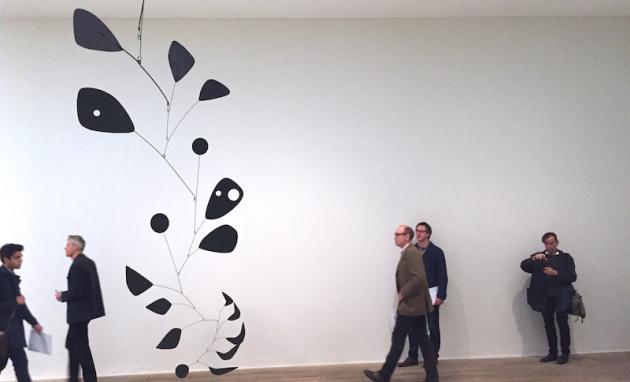Walking into the Tate Modern’s latest exhibition dedicated to the kinetic sculptures of the American giant Alexander Calder, one can’t help being struck by the playfulness of the works. The wire portraits of his artist friends such as Joan Miro and Fernand Leger project shadows on the white walls. His critics have accurately described these transparent circus imageries of horses, elephants and acrobats as ‘drawing in space’ while the light plays tricks with shadows, forms and movement. It is this playfulness that continues throughout the exhibition.
This is the UK’s largest ever exhibition of works by this American giant. Calder (1898-1976) is best known for his ‘mobiles’ (as named by Marcel Duchamp), ‘stabiles’ and as the pioneer of kinetic sculpture playing an essential role in 20th century modernism. The exhibition traces his development from wire sculptures through framed pieces with moving parts to his abstract mobiles.
The exhibition is a calming atmosphere with a gentle transition through the phases of his development to the largest room that houses his mobiles. These are suspended from the ceiling and set against white walls, mingling with the light-wells above and windows beyond. The mobiles command a contemplative effect. They are hypnotic as you watch them gently drift, changing direction and shape as they move. The irony being that you need to be able to watch them in silence and calm to experience this meditative state, yet their movement depends on the room being full of people and the warmth generated by their body heat.
A particular favourite of mine is Snow Flurry I 1948, a series of different sized, circular white discs delicately hanging from twig like wire branches, casting shadows against the window blinds and slowly turning with the heat and movement from the room. Another, Vertical Foliage 1941 consists of assorted sized black-painted boomerang shapes whose skeletal leaves change shape as the light changes and casts ominous shadows on the wall. All around this room the mobiles gently sway playfully in the atmosphere.
The final room is dedicated to a single mobile Black Widow 1948, originally donated by the artist to the Institute of Architects of Brazil in Sao Paolo and loaned abroad for the first time for this exhibition. It exemplifies how Calder’s works define an architectural space rather than simply occupying it.
Calder also experimented with sound. A number of his mobiles incorporated gongs of different pitches while regular spaced beaters produce a series of musical notes. To coincide with the exhibition, Calder’s sculpture Chef d’orchestre 1966 has been installed in the Turbine Hall and will be brought to life by musicians in a series of evening performances. It was created for composer Earle Brown’s Calder Piece 1963-66 in which the movement of the mobile determines the sequence and speed of the music being played by four percussionists.
Words/Photos: Sara Faith © Artlyst 2015

